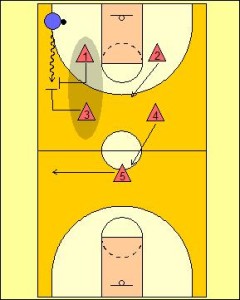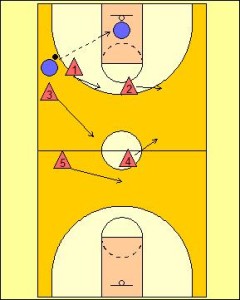2-2-1 Full Court Zone Press
The 2-2-1 Full Court Zone Press is a very commonly used trapping system. When compared to the trapping formations of a 1-2-1-1 or a 1-2-2 the 2-2-1 Full Court Zone Press has a slightly different player rotation that is involved in the trap. This helps provide a different look for the offense to play with.
The 2-2-1 Full Court Zone Press looks to stall the offenses progress of the ball by filling up the backcourt with players stifling the ability to pass out of this area with short sharp passing. This can be a very effective tactic in junior leagues where players are just not that physically capable of making longer passes over the defence and breaking the press.
For senior teams the players will be required to be more active in covering short passing options to try to limit the offense in its movement down the floor.

The shaded areas represent the preferred trapping areas of the 2-2-1 Full Court Zone Press. These can vary however, depending on the principles used. In some cases, these trapping areas could also be extended further up or down the sideline.
When the ball is in the middle of the floor the 2-2-1 Full Court Zone Press looks to just stall the offense’s ball movement and keep the 2-2-1 formation as intact as possible.
As a point of note it would not be unusual for the Five (5) player to also sink further down the court towards the keyway depending on where the furthest offensive player was.

The trapping situation within the 2-2-1 Full Court Zone Press is slightly different as highlighted earlier. In this tapping formation, it is the two players to the side that are involved in the trap. This is of course different to many other trapping formations.
The initial principle of the 2-2-1 Full Court Zone Press is to force offensive players away from dribbling down the middle lane of the floor in preference to being channelled down the sideline. As the offensive player passes by the foul line extended, then the trap can happen anywhere along this sideline.
One (1) and Three (3) in the diagram form the initial trap. Three (3) must ensure the offensive player cannot continue to move down the sideline or crossover dribble and split the two defenders. One (1) on the other hand, stops progress back to the middle of the floor.
Both defenders involved in the trap (One and Three) must learn to play defence with their feet and only allow brief contact with their chest when directly in front of the offensive player. Any other technique will result in a number of unwanted fouls and hurt the team.
As the trap is being initiated the off the ball defenders should be moving into positions which deny passing options close to the ball handler.
Two (2) fills passing targets back towards the middle of the floor.
Four (4) covers all passes across court. This is a pivotal position as many offense will look to breakdown the 2-2-1 Full Court Zone Press through this area of the floor.
Five (5) denies passes down the strong side sideline.

Remember that in most competitions an offensive player cannot hold the ball for longer than a count of five once the defence has forced the pick-up of the ball. For this reason, the players off the ball must be committed to denying close passing options.
If defenders find offensive players moving from one area to another, there must be adequate communication and player exchange to limit these players as passing targets.
It is a common tactic for offensive teams to use long cuts across multiple zone areas to force defenders to rotate and lose the ability to guard close passing targets.

On the reversal of the ball, the 2-2-1 Full Court Zone Press is not used to deny this option but rather re-set the formation.
If the ball is passed back to the inbounder or back behind the line of the ball, then defenders simply rotate back into the 2-2-1 formation as quickly as possible.
Keep in mind the 2-2-1 Full Court Zone Press is about just as much about stalling the play as trapping a player. Eight seconds can burn up very quickly against this type of defence and players must be aware of what the ultimate purpose is to the defence.
Not every offensive possession has to finish in a steal. An expired backcourt count or reduction in shot clock is sometimes enough especially if able to be reproduced constantly within a game.
The time it takes for players to develop the patience and composure to run the 2-2-1 Full Court Zone Press can be lengthy. So plenty of opportunities must be given to practice in 5 v 5 situations during training session situations prior to its use in games.







